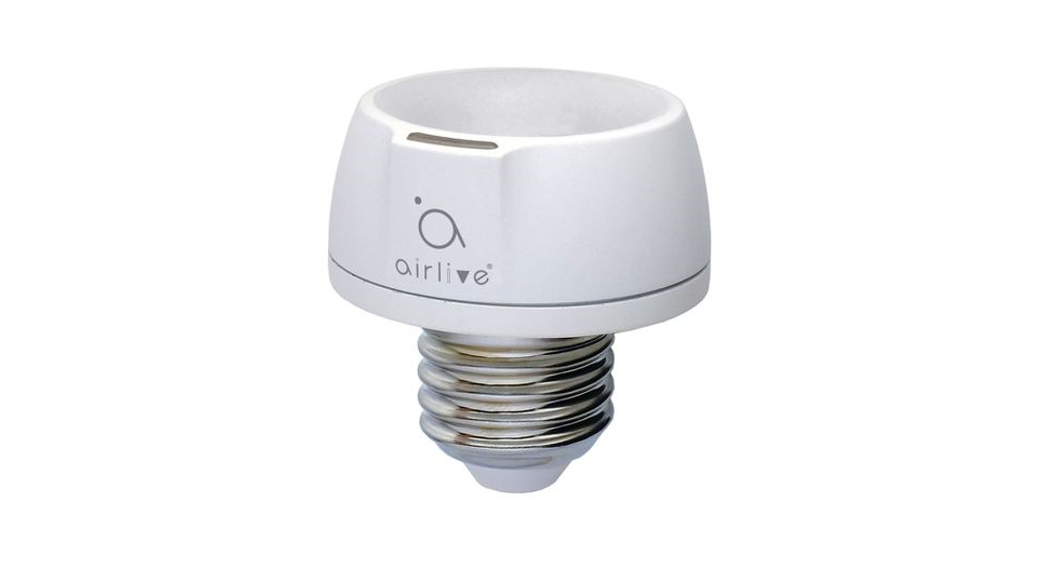
SD-102Smart Dimmer SocketUser Manual

Copyright & Disclaimer
No part of this publication may be reproduced in any form or by any means, whether electronic, mechanical, photocopying, or recording without the written consent of OvisLink Corp.
OvisLink Corp. has made the best effort to ensure the accuracy of the information in this user’s guide. However, we are not liable for the inaccuracies or errors in this guide. Please use with caution. All information is subject to change without notice
This product contains some codes from GPL. In compliance with GPL agreement, AirLive will publish the GPL codes on our website. Please go to www.airlive.com and go to the “Support->GPL” menu to download the source code. All Trademarks are properties of their respective holders.
FCC Interference Statement
This equipment has been tested and found to comply with the limits for a Class B digital device, pursuant to Part 15 of the FCC Rules. These limits are designed to provide reasonable protection against harmful interference in a residential installation. This equipment generates uses and can radiate radio frequency energy and, if not installed and used in accordance with the instructions, may cause harmful interference to radio communications. However, there is no guarantee that interference will not occur in a particular installation. If this equipment does cause harmful interference to radio or television reception, which can be determined by turning the equipment off and on, the user is encouraged to try to correct the interference by one of the following measures:
- Reorient or relocate the receiving antenna.
- Increase the separation between the equipment and receiver.
- Connect the equipment into an outlet on a circuit different from that to which the receiver is connected.
- Consult the dealer or an experienced radio/TV technician for help.
This device complies with Part 15 of the FCC Rules. Operation is subject to the following two conditions:(1) This device may not cause harmful interference, and(2) This device must accept any interference received, including interference that may cause undesired operation.
FCC Caution: Any changes or modifications not expressly approved by the party responsible for compliance could void the user’s authority to operate this equipment. This transmitter must not be co-located or operating in conjunction with any other antenna or transmitter.
Warning
1. Plug out to disconnect from the power supply; Do not plug in line.2. Do not exceed the max rating.
Disposal
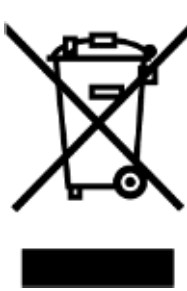 This marking indicates that this product should not be disposed of with other household wastes throughout the EU. To prevent possible harm to the environment or human health from uncontrolled waste disposal, recycle it responsibly to promote the sustainable reuse of material resources. To return your used device, please use the return and collection systems or contact the retailer where the product was purchased. They can take this product for environmentally safe recycling.
This marking indicates that this product should not be disposed of with other household wastes throughout the EU. To prevent possible harm to the environment or human health from uncontrolled waste disposal, recycle it responsibly to promote the sustainable reuse of material resources. To return your used device, please use the return and collection systems or contact the retailer where the product was purchased. They can take this product for environmentally safe recycling.
Overview
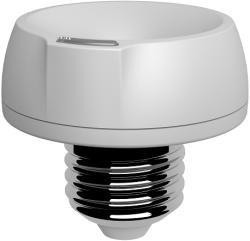
SD-102 is an E27(EU)/ E26(US) Edison screw-based lamp socket, which provides an electrical connection to the E14(EU)/ E12(US) Edison screw-based lamps and supports it in the lighting fixture. The use of sockets allows lamps to be safely and conveniently replaced. You can On/Off the light by pressing the button briefly, or a long pressing to control the brightness of the dimmable lightbulb. This dimmer is a transceiver which is a security-enabled device based on Z-Wave Plus technology, and it is fully compatible with any Z-Wave™ -enabled network. Since SD-102 supports Security Command Class, it can learn with a Secured controller. Its functionality and supported command classes are identical when included as a secure and non-secure device.
Adding to Z-Wave ™ Network
In the front casing, there is an on/off button with LED indicator below which is used to switch on and off or carries out inclusion, exclusion, reset or association. When first power applied, its LED flashes on and off alternately and repeatedly at 0.5-second intervals. It implies that it has not been assigned a node ID and start auto inclusion.
Auto Inclusion
The function of auto inclusion will be executed as long as the dimmer does not have Node ID and just connect the switch to main power.
Note: Auto inclusion timeout is 2 minute during which the node information of explorer frame will be emitted once every several seconds. Unlike “inclusion” function as shown in the table below, the execution of auto inclusion is free from pressing the On/Off button on the dimmer.The table below lists an operation summary of basic Z-Wave functions. Please refer to the instructions for any Z-Wave™ Certificated Primary Controller to access the Setup function, and to include/exclude/associate devices.
| Function | Description |
Annotation |
| No node ID | The Z-Wave Controller does not allocate a node ID to the Switch. | LED 2-second on, 2-second off |
| Add (Inclusion) | Put your Z-Wave controller into inclusion mode by following the instructions provided by the controller manufacturer. | One press one flash LED |
| Pressing Include button of SD-102 three times within 2 seconds will enter inclusion mode. | ||
| Remove (Exclusion) | Put your Z-Wave controller into exclusion mode by following the instructions provided by the controller manufacturer. | One press one flash LED |
| Pressing Include button of SD-102 three times within 2 seconds will enter exclusion mode. | ||
| Node ID has been excluded. | 0.5s On, 0.5s Off (Enter auto inclusion) | |
| Reset | Pressing Include button of SD-102 three times within 2 seconds will enter inclusion mode. | Use this procedure only in the event that the primary controller is lost or otherwise inoperable. |
| Within 1 second, press Include button of SD-102 again for 5 seconds. | ||
| IDs are excluded. | 0.5s On, 0.5s Off (Enter auto inclusion) |
| Association | The SD-102 is an always-listening Z-Wave device, so associations may be added or removed by a controller at any time.
Or If your controller requires to have the SD-102 send a ‘node information frame’ or NIF for associations, then pressing the On/Off button three times within 2 seconds will cause the SD-102 to send its NIF. |
| There is only one group for the dimmer. | |
|
LED Indication
To distinguish what mode the switch is in, view from the LED for identification.
| State Type | LED Indication |
| Normal | Whenever we switch On and off of the SD-102 by On/Off button or RF command, the LED will lights up when switch on; whereas LED off when switch off. |
| No node ID | Under normal operation, when the Switch has not been allocated a node ID, the LED flashes on and off alternately at 2-second intervals. By pressing On/Off button, it will stop flashing temporarily. |
| Learning | When SD-102 is in learning mode, LED flashes on and off alternately and repeatedly at 0.5 second intervals. |
Choosing a Suitable Location
- Do not locate the dimmer facing direct sunlight, humid or dusty place.
- The suitable ambient temperature for the Switch is 0°C~40°C.
- Do not locate the dimmer where exists combustible substances or any source of heat, e.g. fires, radiators, boiler etc.
- After putting it into use, the body of dimmer will become a little bit hot of which phenomenon is normal.
Manual dim level control
To manually switch on the light, press and release the On/Off button shortly when the light is off. The light will dim from off to the level which was set before switch off. To manually switch off the light, press and release the On/Off button shortly when the light is on. To adjust the dim level, press and hold the On/Off button until the desired dim level is achieved, then release.
Programming
1.6.1. Basic Command Class / Multilevel Switch Command Class The dim level can be set by BASIC and MULTILEVEL SWITCH commands.
1.6.1.1. BASIC_GETUpon receipt of the following commands from a Z-Wave Controller, the dimmer will report its dim level to the node inquiredBasic Get-Command: [Command Class Basic, Basic Get]Basic Report Command:Report OFF: [Command Class Basic, Basic Report, Value = 0 ]Report ON:[Command Class Basic, Basic Report, Value = 1~99 ]
1.6.1.2. BASIC_SETUpon receipt of the following commands from a Z-Wave Controller, the dimmer will be set to the dim level.Basic Set Command:[Command Class Basic, Basic Set, Value = 1~99 ]: the light attached to the dimmer turns on.Basic Set Command:[Command Class Basic, Basic Set, Value = 0 ]: the light at- attached to the dimmer turns off.
1.6.1.3. MULTILEVEL SWITCH GETUpon receipt of the following commands from a Z-Wave Controller, the dimmer will report its dim level to the node inquired.Multilevel Switch Get-Command: [Command Class Multilevel Switch, Multilevel Switch Get]
| Multilevel Switch Report Command:Report OFF: [Command Class Multilevel Switch, Multilevel Switch Report, Value = 0 ]Report ON:[Command Class Multilevel Switch, Multilevel Switch Report, Value = 1~99 ] |
1.6.1.4. MULTILEVEL SWITCH GETUpon receipt of the following commands from a Z-Wave Controller, the dimmer will be set to the dim level.
| Multilevel Switch Set Command: [Command Class Multilevel Switch, Multilevel Switch Set, Value = 1~99, Duration = 0~255 ]: the light attached to the dimmer turns on. |
| Multilevel Switch Set Command: [Command Class Multilevel Switch, Multilevel Switch Set, Value = 0, Duration = 0~255 ]: the light attached to the dimmer turns Off. |
1.6.2. Z-Wave’s Group (Maximum 1 node)The dimmer can be set to send reports to associated Z-Wave devices. It supports one association group with one node support for Grouping 1. For group 1, the dimmer will report ALARM_REPORT and DEVICE_RESET_LOCALLY_NOTIFICATION.
1.6.2.1. Overload alarm reportWhen SD-102 detects overload, it will send Alarm Report to group 1 node. After de- tecting overload state and sending this alarm report, SD-102 will turn off the light automatically and lockout the On/Off button. The only thing to do is unplug SD-102 and reduce the load. Then replug SD-102 and it will work again.The content of Alarm Report
| Alarm report command: [Command_Class_Alarm, Alarm_Report, Alarm Type = 0x08, Alarm Level = 0xFF] |
1.6.3. Z-Wave’s Configuration
| ConfigurationParameter | Function | Size
(Byte) |
Value | Unit | Default | Description |
| 1 | Mode of SwitchOff function | 1 | 0-1 | 1 | 0: Disable1: Enable | |
| 2 | LED indicationmode | 1 | 1-2 | 1 | 1: Show switch state2: Show night mode | |
| 3 | Auto off timer | 2 | 0-0x7FFF | 1s | 0 | 0: Disable auto off function1-0x7FFFF: 1s~32767s |
| 4 | RF off commandmode | 1 | 0-3 | 0 | 0: Switch off1: Ignore2: Switch toggle3: Switch on |
1.6.3.1. Mode of switch-off function
When the mode of switch On/Off is set to 0, any command of switch-off will be disabled and the On/Off function of the include button will be disabled. The default setting is enabled mode.
1.6.3.2. LED indication mode
1. Show Switch State: When the switch is on, LED is on. When the switch is off, LED is off. The default setting is Show Switch State.2. Show Night mode: When the switch is on, LED is off. When the switch is off, LED is on.
1.6.3.3. Auto-off timer
Whenever SD-102 switches to on, the auto-off timer begins to count down. After the timer decrease to zero, it will switch off automatically. However, if the Auto-off timer is set as 0, the auto-off function will be disabled. The default setting is 0.
1.6.3.4. RF off command mode
Whenever a switch-off command, BASIC_SET, BINARY_SWITCH_SET, SWITCH_ALL_OFF, is received, it could be interpreted as 4 variety of commands.1. Switch Off: It switches to OFF state. The default setting is Switch Off.2. Ignore: The switch-off command will be ignored.3. Switch Toggle: It switches to the inverse of the current state.4. Switch On:It switches to ON state.
1.7 Firmware Update Over the Air (OTA)SD-102 is based on 500 series SoC and supports Firmware Update Command Class, it can receive the updated firmware image sent by the controller via the Z- wave RF media. It is a helpful and convenient way to improve some functions if needed.
1.8 Command ClassThe Switch supports Command Classes including…COMMAND_CLASS_ZWAVEPLUS_INFOCOMMAND_CLASS_VERSION_V2COMMAND_CLASS_MANUFACTURER_SPECIFIC_V2COMMAND_CLASS_SECURITYCOMMAND_CLASS_DEVICE_RESET_LOCALLYCOMMAND_CLASS_ASSOCIATION_V2COMMAND_CLASS_ASSOCIATION_GRP_INFOCOMMAND_CLASS_POWERLEVELCOMMAND_CLASS_BASICCOMMAND_CLASS_SWITCH_MULTILEVEL_V2COMMAND_CLASS_CONFIGURATIONCOMMAND_CLASS_ALARMCOMMAND_CLASS_FIRMWARE_UPDATE_MD_V2COMMAND_CLASS_SCENE_ACTIVATIONCOMMAND_CLASS_SCENE_ACTUATOR_CONF
Screw Lampholder type
Since the socket type for each country in Europe varies, refer to the outline for each socket suited for each country as follows.
EU Type: SD-102-1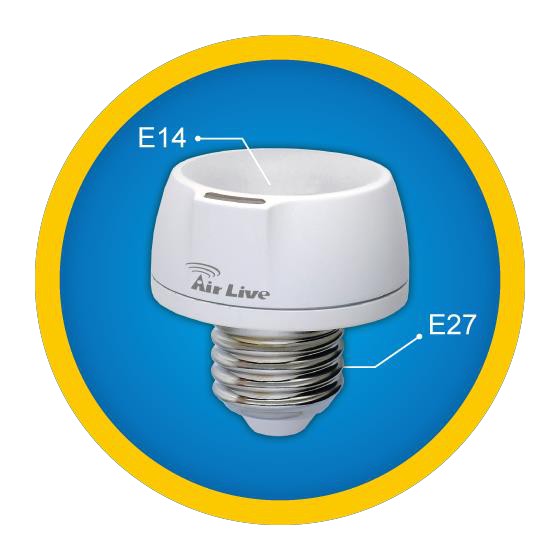
US Type: SD-102-2
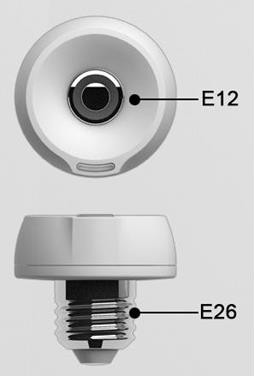
Note: Please make sure that the intensity of the screw lamp holder of the electrical device must be Maximum Load (Ampere) and have the same head as the enclosed screw lamp holder before inserting to the socket.
Troubleshooting
|
Symptom |
Cause of Failure |
Recommendation |
| The dimmer does not work and LED off | 1. The dimmer is not plugged into the electrical outlet properly 2.The dimmer breakdown | 1. Check power connections2. Don’t open up the dimmer and send it for repair. |
| The dimmer LED illuminating, but cannot control the ON/OFF state of the load attached | 1. Check if the load plugged into the dimmer has its own ON/OFF switch.
2. The dimmer is protected. |
1. Set the ON/OFF switch of the load attached to ON2. Unprotected the switch or follow the instruction of protection. |
| The dimmer LED illuminating, but the Detector cannot control the Switch | 1. Not carry out association2. Same frequency interference | 1. Carry out association2. Wait for a while to re-try |
Specification
| Operating Voltage | 100-240Vac / 50Hz-60Hz |
| Maximum Load (Ampere) | 1A (Resistive load) |
| Maximum Load (Ampere) | 0.1A (Dimmable LED bulbs) |
| Screw lampholder type | EU type: E27 to E14 |
| US type: E26 to E12 | |
| Range | Minimum 40 m in door 100m outdoor line of sight |
| Frequency Range | 868.40MHz & 869.85MHz/ EU (SD-102-EU); 908.4MHz & 916.0MHz/ USA (SD-102-US); |
| Operating Temperature | 0°C – 40°C |
** Specifications are subject to change and improvement without notice.
 OvisLink Corp.,http://www.airlive.com/TEL: +886 2 2218 6888FAX: +886 2 2918 6988
OvisLink Corp.,http://www.airlive.com/TEL: +886 2 2218 6888FAX: +886 2 2918 6988
![]()
References
[xyz-ips snippet=”download-snippet”]

